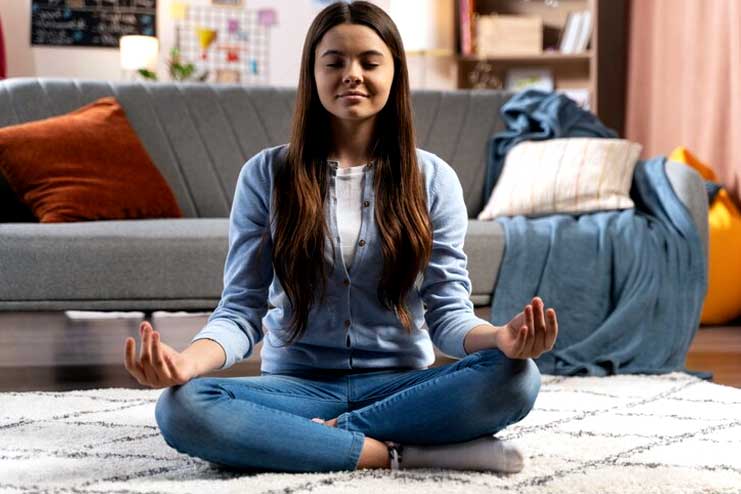Affiliate Disclaimer
Some links in this article are affiliate links. We may earn a small commission if you make a purchase through these links, at no extra cost to you. We only recommend products we find useful to our readersThe foundation of a happy and healthy family life is getting enough sleep, which is essential for each family member’s general well-being. Understanding the value of restorative sleep is crucial for fostering mental acuity, emotional equilibrium, and physical well-being. A healthy family dynamic increasingly depends on prioritizing sleep in our fast-paced world of constant demands on time and attention.
This article emphasizes how crucial it is to use family-friendly sleep quality-improving techniques to promote a shared commitment to each member’s health and vitality. Making rest a priority is a shared duty that supports the resilience and contentment of the family, not simply an individual need.
7 Family Oriented Sleep Solutions for Better Rest


Discover these valuable and efficient family-friendly sleep solutions that promote better sleep and help you lead a healthier, more balanced existence.
1. Setting Consistent Sleep Schedules
Promoting optimal health in adults and children begins with regular sleep routines. Regular sleep habits lay the groundwork for mental clarity, emotional stability, and physical health.
Regular bedtimes and wake-up times provide routine and predictability that benefit adults and children. According to recent studies, obtaining eight hours of sleep every night may not be as crucial as maintaining a regular sleep routine. Your internal circadian rhythm can function more effectively when your sleep and wake times are standard.
It helps you get to sleep and helps in staying asleep more quickly. Consequently, this improves mood and performance during the day. Regular sleep schedules are essential for kids since they promote learning, development, and growth.
Create a night-time routine with soothing activities and limit screen time before bed to help your family establish and follow regular sleep habits. Family members should be aware of the value of sleep and its connection to general health. You should also arrange and align bedtimes to establish a synchronised and supportive family sleep environment and guarantee that everyone gets the full advantages of a restful night’s sleep.
2. Creating a Relaxing Bedtime Routine


The bedtime ritual is a valuable aid in improving sleep, providing a calm transition from the stresses of the day to a peaceful night’s sleep. Stressing the need to relax before bedtime is crucial for promoting calmness and getting kids and adults ready for rest.
Family members should be encouraged to incorporate relaxing activities into their night-time night-time routine. Wind-down time is when you do things to help you unwind and prepare for a restful night’s sleep. You can read a book, write in a diary, stretch, meditate, deep breathe, and listen to calming music. You can also turn off screens and engage in other peaceful activities. These exercises facilitate a more seamless transition into a restful state by sending signals to the body and mind that it’s time to relax.
Creating calming night-time night-time routines that appeal to every family member can help accommodate their varied tastes. Whether it’s a relaxing music playlist, a quick family meditation, or a shared story time, adjusting the routine to suit individual preferences promotes inclusivity and well-being. Families may make bedtime a treasured and revitalizing ritual by coming together to adopt a peaceful routine to ensure everyone gets a good night’s sleep.
3. Designing Sleep-Inducing Bedrooms


It is impossible to overestimate the importance of creating a sleep-friendly bedroom environment because it directly affects how well each family member sleeps. Aim for well-rounded bedroom optimization by strategically adjusting to meet the needs and tastes of each individual. A peaceful setting is necessary for a restful night’s sleep.
Research indicates that individuals sleep more soundly when their bedroom is well-suited in terms of temperature, comfort, light, noise levels, etc. Additionally, a sleep-promoting bedroom atmosphere might enhance your waking state of consciousness, given the apparent correlation between sleep duration, quality, and other facets of human health.
Reduce the amount of artificial light and use blackout curtains to create a calming, dark ambiance. To create a calm atmosphere, reduce noise disruptions with soft furnishings and soundproofing techniques. Aside from that, ensure your room or mattress is at the proper temperature for sleeping.
Selecting cozy bedding is essential for improving the quality of your sleep. Invest in pillows and mattresses, offering enough support and comfort to every family member. Using soft, breathable linens can enhance the appeal of the sleeping environment.
Families may create a peaceful and restful sleeping environment in their bedrooms by implementing these tips. Adapting the sleeping environment to each person’s needs improves the quality of sleep overall and encourages a feeling of renewal and well-being for all members of the household.
4. Encouraging Healthy Sleep Habits


Healthy sleeping patterns are essential for everyone’s well-being, including adults and children. According to studies, using a screen for two or more hours in the evening can significantly interfere with the melatonin surge that induces sleep. Try to switch off all electronics an hour or more before going to bed. Try bathing, reading a book, or engaging in other soothing activities. Families can enhance sleep quality and promote better physical and mental health by encouraging healthy routines.
Reducing the time spent on screens before bed is essential for developing sound sleeping habits. Screen blue light can interfere with the body’s normal circadian rhythm, making it more difficult to fall asleep. Promote activities that don’t require screens to wind down, like reading, light stretching, or having soothing talks.
Stress the value of avoiding coffee and large meals right before bed. These may make it difficult for the body to unwind and cause discomfort when you sleep. If need be, choose light, easily digested foods instead.
Families may foster a sleep environment by implementing these recommendations throughout everyday activities. Better sleep quality and overall family well-being are facilitated by consistent routines customized to each individual’s needs.
5. Promoting Physical Activity for Better Sleep


Exercise is frequently the key to unlocking the secret to improved sleep. Regular exercises have been linked to better sleep, providing a natural and comprehensive way to promote overall health for all family members. According to studies, exercising can help you get enough sleep and relieve sleep-related issues. According to recent studies, getting too little or poor sleep the night before may also cause people to be less active the next day.
Regular physical activity has been demonstrated to improve sleep quality by regulating sleep cycles, lowering stress levels, and fostering a sense of relaxation. Including family-friendly physical activities in everyday routines becomes an enjoyable and successful tactic for adults and kids.
Promote outside activities like bike rides, family walks, and even easy backyard games. Dance parties, yoga classes, and interactive video games that encourage group movement are examples of indoor activities. Families that engage in physical activity get better sleep, fortify their ties, and make enduring memories.
These fun physical exercises for the whole family help with sleep improvement and lay the groundwork for a healthy lifestyle. Every family member benefits from better physical and emotional health and a more restful night’s sleep when combined with exercise and quality time.
6. Managing Stress and Anxiety


For each family member’s health, controlling stress and anxiety is essential to get good sleep. Stress is a natural aspect of life, from small obstacles to big problems. Furthermore, although your circumstances are often beyond your control, how you react to them is essential. Stress can hurt your well-being if it becomes excessive or persistent. Having efficient stress relievers helps relax your body and mind. Families can cultivate a sense of calm that promotes healthy sleep by implementing stress-relief practices and maintaining a peaceful night-time atmosphere.
Examine age-appropriate stress-reduction methods, including mindful meditation, deep breathing exercises, and mild yoga asanas. These activities relieve stress and prepare kids and adults for a more laid-back nighttime routine.
The best ways to create a stress-free sleeping environment are to keep the room’s temperature comfortable, reduce distractions, and add relaxing features like ambient sounds or calming colors. Creating a regular bedtime ritual can help the body receive the signal to relax and promote a calmer sleep cycle.
Family members should be encouraged to communicate openly to combat anxiousness before bed. Establish a comforting environment where worries can be voiced and use progressive muscle relaxation or guided imagery to calm racing thoughts. Families may create an atmosphere that supports sound sleep and general well-being by working together to manage stress and anxiety.
7. Navigating Sleep Challenges Together


It is essential to address the different sleep problems that adults, teens, and children can have to promote a peaceful sleep environment in the home. Taking up sleep-related issues as a family improves ties and protects each individual’s health.
A young child’s health and development depend on getting enough sleep, yet about half of them have sleep problems at some point. Sleep apnea, insomnia, and parasomnias—disturbing sleep-related behaviors including sleepwalking and night terrors—are common sleep problems in children. Maintaining a united front in the face of these difficulties requires honest communication and a dedication to working together to discover workable solutions.
Teens with sleep issues can stay up at night even when they want to sleep. Teens who don’t get enough sleep have difficulties in their academic and athletic lives. They might experience additional emotional issues or feel grumpy or depressed. Additionally, youths who drive under the influence of sleep have a higher risk of auto accidents.
Families might use tactics adapted to each member’s unique needs to manage sleep disorders or disturbances. It can entail establishing a regular bedtime schedule, modifying sleep settings, or, if required, contacting a professional for advice. Fostering compassion and comprehension among family members creates a support framework for dealing with sleep issues.
Conclusion
Making family-friendly sleep solutions a priority will open up a world of advantages for all household members. Regular sleep schedules, calming bedtime rituals, and collaborating to manage stress are all behaviors that lead to better sleep quality and increased well-being. By implementing these suggestions, families can foster better sleep habits, physical well-being, emotional equilibrium, and closer bonds. Accept the transforming power of good sleep and observe how it improves the general health and harmony of the family.
Use these family-friendly sleep options to start along the path to a happier, healthier family life. Good sleep is the foundation of your family’s health; prioritize it now for a more comfortable, closer-knit community tomorrow.
Related Articles:
- Importance of Sleep Hygiene:Creating Your Ideal Sleep Environment
- Beauty Sleep Hacks: 10 Tips for Glowing Skin and Restful Nights
Reference
https://www.verywellhealth.com/consistency-the-key-to-better-sleep-quality-8404052#:~:text=New%20research%20suggests%20that%20having,asleep%20faster%20and%20stay%20asleep.
https://newsinhealth.nih.gov/2021/04/good-sleep-good-health#:~:text=But%20sleep%20is%20as%20important,stroke%20to%20obesity%20and%20dementia.
https://www.mentalhealthfirstaid.org/2021/03/five-ways-to-wind-down-and-relax-before-bed/
https://www.verywellhealth.com/favorite-ways-to-relax-before-bedtime-and-improve-sleep-3014977
https://www.sleepfoundation.org/bedroom-environment#:~:text=You%20should%20strive%20to%20keep,when%20they%20go%20to%20bed.
https://www.cnet.com/health/sleep/create-the-perfect-environment-for-better-sleep-with-these-tips/#google_vignette
https://www.sutterhealth.org/health/sleep/screens-and-your-sleep-the-impact-of-nighttime-use#:~:text=Studies%20show%20two%20or%20more,other%20type%20of%20relaxing%20activity.
https://www.sleepfoundation.org/children-and-sleep/how-blue-light-affects-kids-sleep#:~:text=Blue%20light%20from%20screens%20disrupts,production%20of%20sleep%2Dinducing%20melatonin.
https://www.sleepfoundation.org/physical-activity/exercise-and-sleep#:~:text=The%20Best%20Times%20to%20Exercise%20for%20Healthy%20Sleep&text=These%20include%20yoga%2C%20light%20stretching,wake%20up%20feeling%20well%20rested.
https://www.hopkinsmedicine.org/health/wellness-and-prevention/exercising-for-better-sleep#:~:text=Based%20on%20available%20studies%2C%20%E2%80%9CWe,at%20Howard%20County%20General%20Hospital.
https://www.betterhealth.vic.gov.au/health/healthyliving/Physical-activity-how-to-get-active-when-you-are-busy
https://www.cdc.gov/violenceprevention/about/copingwith-stresstips.html#:~:text=Take%20deep%20breaths%2C%20stretch%2C%20or,Get%20plenty%20of%20sleep.
https://www.sleepfoundation.org/sleep-hygiene/how-to-relieve-stress-for-bedtime
https://www.canr.msu.edu/news/strategies_to_cope_with_family_stress#:~:text=Read%20a%20book%2C%20sit%20on,for%20a%20minute%20or%20so.
https://kidshealth.org/en/teens/sleep.html
https://www.sleepfoundation.org/children-and-sleep/sleep-disorders-in-children
https://www.sleepfoundation.org/teens-and-sleep































